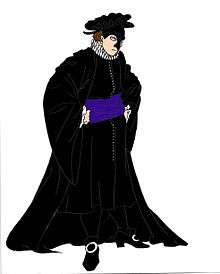Il Dottore

Il Dottore [il dotˈtoːre] or the Doctor (usually called Dottor Balanzone [balanˈtsoːne], Dottor Baloardo [baloˈardo], or Dottor Graziano [ɡratˈtsjaːno]) is a commedia dell'arte stock character, one of the vecchi or old men whose function in a scenario is to be an obstacle to the young lovers. Pantalone and Il Dottore are the alter ego of each other, Pantalone being the decadent wealthy merchant, and Il Dottore being the decadent erudite.[1]
Overview
The Doctor is a vocal, angry, disruptive who doesn't listen to anyone else from any of the fields that he claims to know about, which are many (medicine, law, etc.). He is traditionally portrayed as having been educated either in Bologna or Padua, which since the Renaissance had two of the most prestigious universities of Europe. He is often extremely rich, generally with "old" money, though the needs of the scenario might have things otherwise. He is extremely pompous, and loves the sound of his own voice, spouting ersatz Latin and Greek. His interaction in the play is usually mostly with Pantalone, either as a friend, mentor or competitor.
He is typically depicted as an elderly man who only knows nonsense. He makes many cruel jokes about the opposite sex and believes that he knows everything about everything. He is an obese man that enjoys the bottle and eating to excess.
His mask is unique in that it is the only mask in commedia dell'arte to cover only the forehead and nose. This is often used to create a phallic effect. It is sometimes black, or else flesh-toned with a red nose.
Traditional names for the Doctor include Dr. Baloardo (English: 'Dr. Stupid') and Dr. Spaccastrummolo (English: 'Dr. Hack-and-Bandage.') [2] His costume is usually all or mostly black, sometimes with a white collar. He frequently wears a hat, and long, trailing robes. If the actor playing the role is not naturally plump then he is padded out to make him seem so.
See also
References
- ↑ Robert Henke Performance and literature in the commedia dell'arte, Improvvisation and characters, Individual roles, pp.19-24
- ↑ https://sites.google.com/site/italiancommedia/the-characters
- Rudlin, John; Oliver Crick (2001). Commedia dell'arte. Routledge. ISBN 978-0-415-20409-5. Retrieved August 4, 2009.
- The Italian Comedy by Pierre Louis Duchartre